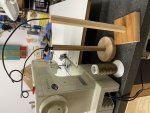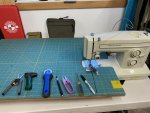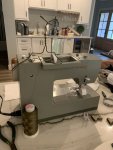Hootsma
Lil-Rokslider
I finally took the plunge and bought a sewing machine so I can finally retire my sewing awl and get after all those mods I've been wanting to tackle. I've never really sewn before, except for some hand stitching and awl stitching, so this is a whole new world for me.
I purchased a refurbished Singer HD 4452 and it should be delivered tomorrow. I have a few 'getting started' questions I was hoping y'all could help me with.
Lets start with stitch type. This machine has 32 stitches that it is capable of with the turn of a dial. Way more than I'll ever use, but it's nice to have the variety and flexibility for what I anticipate being a very deep and wide rabbit hole. Some of the more applicable stitches this machine is capable of are the following:
1) Standard straight stitch with variable length
2) Zig zag stitch with variable length and width
3) Multi-step Zig zag stitch with (3) stitches each direction with variable length and width
4) Straight stretch stitch (I think it's AKA a back stitch) where it stitches 2 forward and one back each time with variable length
5) Multi-step Zig Zag with back stitching which does the (3) stitches in each direction in conjunction with the back stitch and has variable length and width.
6) Automatic button hole bar tack with variable length (this one seems like it'd work well for bar tacking webbing to cordura?)
If your familiar with the 4452, feel free to add other applicable/useful stitches that I may have overlooked.
So, my first question is which stitch for which application?
Specifically, my first task is going to be adding tap loops with 3-bar sliders to a cargo panel. This will be used to attach the cargo panel to the common loops on my frame for heavy meat hauling applications. So, it will be a high stress application. Which stitch is best for this type of high stress application and at what length/width settings? As a side note, I am familiar with the box X stitch for webbing. I've done it several times by hand and with my sewing awl on 1" webbing and each one takes me about 4 hours to complete, hence the plunge into the sewing machine world.
Next is thread. I purchased Bonded Nylon66 thread in both V69 and V92 weights. Which one of these should I be using for the above application or should I be looking for another type of thread?
And lastly, needle size. This machine will come with "heavy duty" needles, but they never tell you what gauge the needles are. What gauge/type of needle should I be using for sewing through multiple layers of webbing and 500d cordura and that fits y'alls recommended thread size for my applications?
If it's easier to talk about over the phone, send me a PM about it and I'll send you my phone number.
Thanks in advanced for any help and guidance.
Cheers,
Robert Merrell
I purchased a refurbished Singer HD 4452 and it should be delivered tomorrow. I have a few 'getting started' questions I was hoping y'all could help me with.
Lets start with stitch type. This machine has 32 stitches that it is capable of with the turn of a dial. Way more than I'll ever use, but it's nice to have the variety and flexibility for what I anticipate being a very deep and wide rabbit hole. Some of the more applicable stitches this machine is capable of are the following:
1) Standard straight stitch with variable length
2) Zig zag stitch with variable length and width
3) Multi-step Zig zag stitch with (3) stitches each direction with variable length and width
4) Straight stretch stitch (I think it's AKA a back stitch) where it stitches 2 forward and one back each time with variable length
5) Multi-step Zig Zag with back stitching which does the (3) stitches in each direction in conjunction with the back stitch and has variable length and width.
6) Automatic button hole bar tack with variable length (this one seems like it'd work well for bar tacking webbing to cordura?)
If your familiar with the 4452, feel free to add other applicable/useful stitches that I may have overlooked.
So, my first question is which stitch for which application?
Specifically, my first task is going to be adding tap loops with 3-bar sliders to a cargo panel. This will be used to attach the cargo panel to the common loops on my frame for heavy meat hauling applications. So, it will be a high stress application. Which stitch is best for this type of high stress application and at what length/width settings? As a side note, I am familiar with the box X stitch for webbing. I've done it several times by hand and with my sewing awl on 1" webbing and each one takes me about 4 hours to complete, hence the plunge into the sewing machine world.
Next is thread. I purchased Bonded Nylon66 thread in both V69 and V92 weights. Which one of these should I be using for the above application or should I be looking for another type of thread?
And lastly, needle size. This machine will come with "heavy duty" needles, but they never tell you what gauge the needles are. What gauge/type of needle should I be using for sewing through multiple layers of webbing and 500d cordura and that fits y'alls recommended thread size for my applications?
If it's easier to talk about over the phone, send me a PM about it and I'll send you my phone number.
Thanks in advanced for any help and guidance.
Cheers,
Robert Merrell



